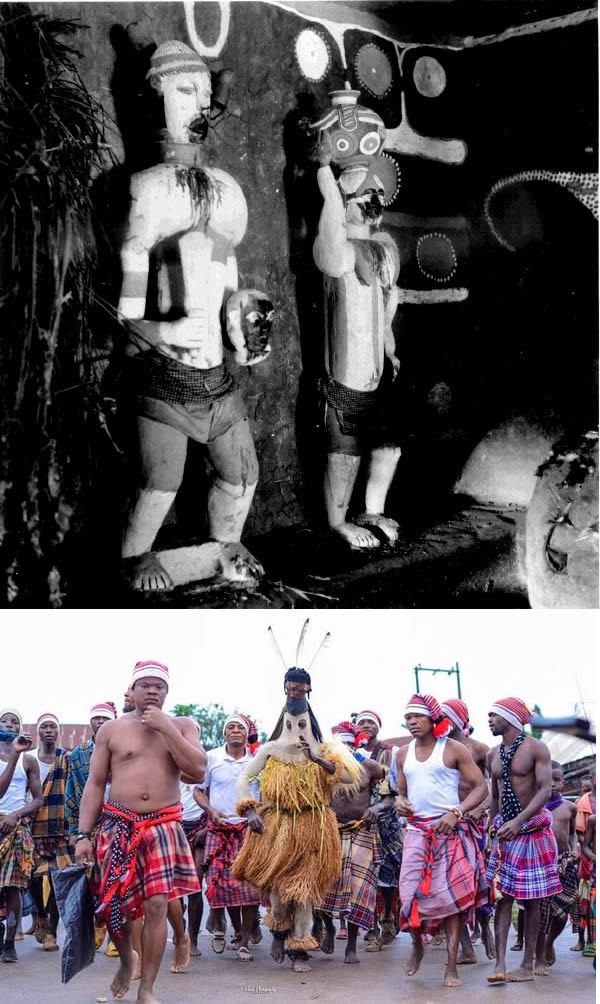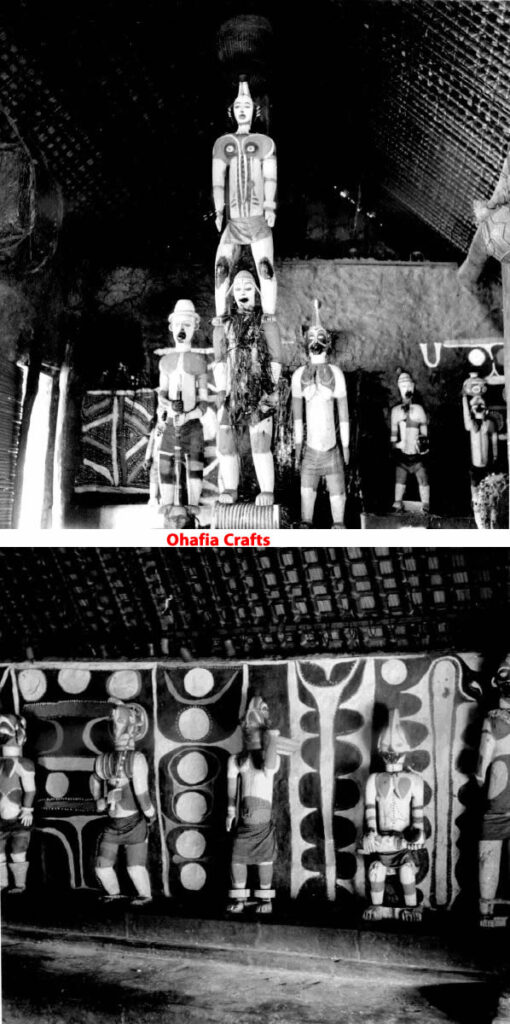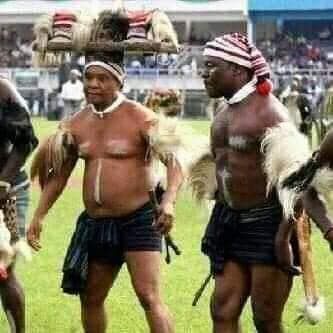The history of Ohafia, Nigeria is marked by a warrior tradition and a matrilineal society:
Warrior tradition
The Ohafia people are known for their warrior heritage, which is a central part of their identity. The Ohafia warrior tradition is celebrated in the iri agha and ikpirikpi ogu performances:
- Iri agha: The iri agha is a performance that embodies the Ohafia warrior tradition.
- Ikpirikpi ogu: The ikpirikpi ogu is a performance that involves beheading a fallen enemy. A human skull was a symbol of strength and courage, and only those who could bring home a skull could join the Ogbu-Isi society.
Matrilineal society
Ohafia is a matrilineal society, where land is communally owned by both the paternal and maternal families. However, some say that the matrilineal system has negatively affected women’s and children’s education.
- Colonialism
Colonialism changed Ohafia society in several ways:
- Education: Colonialism replaced warfare and slave raids with education.
- Produce trade: Ohafia people participated in the produce trade, but their participation was limited due to a lack of resources.
- Migration: Ohafia people migrated to urban centers in Nigeria and beyond to benefit from the colonial economy.
Brief History of Ohafia
According to history, Ohafia people are said to have emigrated from Angoli to Isi-Eke but fled the area one night when they sensed they were being attacked. Many headed towards Ngodo, while others went opposite Isuochi. A man, Ezeama Atita, and his sons known as Uduma Ezeama and Onyereobi Ezerama, led some toward Abam. On reaching Abam, the condition of the wife of Ezeama’s son, Onyereobi due to pregnancy, forced them to settle down there, while others continued their journey.
Ohafia is an Igbo clan as well as a local government area (LGA) which covers the entire Ohafia villages and other clans such as Abiriba and Nkporo, in Abia State. It has its Administrative Headquarters at Ebem Ohafia while its ancestral capital is the centrally located village of Elu Ohafia. There are 26 villages in Ohafia which were birthed by offspring of Ezeama Atita and his second son, Uduma which include; Elu, Ibina (Ihenta), Nde Okala, Nde Anyaorie, Amuma, Amaekpu, Ebem, Nde Amogu, Okagwe, Nde Uduma Ukwu, Oboro, Nde Nku, Nkwebi, Amuke, Asaga, Ndi Uduma Awoke, Amankwu, Nde Ibe, Nde Orieke, Okon-aku, Amangwu, Ufiele, Eziafor, Abia, Akanu, Isiugwu.
Each village is governed by an Eze Ogo. All the Eze Ogos make up the Eze Ogo-in-Council, which, with the ‘amala’, decide how the community is to be governed. The overall traditional ruler is known as Udumeze and he lives in Elu Ohafia. Udumeze is said to intervene only when there is a matter between an eze ogo and a subject.
Ohafia is also endowed with rivers such as the Mmori River in Ebem, located along the road bridging Ohafia to Abam. The Ifutiti Waterfall located at Amaekpu which is more than 300 feet deep and another waterfall at Uzoasuga in Akanu Ohafia, are beautiful tourism sites.


Ohafia traditional hospitality
The legendary traditional dance known as Ohafia War Dance, is one legend that has so much suppressed other rich cultural heritage of these people found in Abia State, in the Southern part of Nigeria.
The cultural hospitality of the Ohafia people is quite fascinating. The people shouldn’t just be known for their legendary war dance but also, how they welcome visitors into their homes with respect; depicting love and brotherliness. Interestingly, the Ohafia traditional hospitality is typical of the Igbos who see it as a taboo to ill-treat strangers. In fact, till date, the Igbos would go out of their way to be nice to a stranger, believing as its written in the Holy Bible, that by so doing they could be entertaining an Angel. This is one of the cultural similarities the Igbos share with the Israelites; one of the reasons they are described as the lost tribe of Israel.
Visitors are usually welcome in Ohafia with native white chalk known in Igboland as Nzu. For a male visitor, the Nzu is rubbed on his hand, while the female applies it on either her neck or tommy. This act according to indigenes, is in no way fetish. It is done to prove that the visitor is welcome, and also, if it is accepted by the visitor, proves that the visitor has come in peace.
After Nzu has been given to the visitor, the next welcome gift is Kolanut. Note that the presentation of kolanut is till date, a custom that Ndigbo do not toil with.
As it is in Igboland, in Ohafia, the oldest man in the house blesses the kolanut as well as those that will partake in its eating. The kolanut is then broken by the youngest male in the house. The head of the house takes first followed by the visitor, before other males; usually from oldest to youngest.
If there are any women present, they pick last. Sharing of the kolanut is followed by drink- usually locally brewed gin is used to water down the kolanut. The gin is also shared in the same order they did the kolanut. You won’t believe it, everyone present drinks from the same cup.
Why Nzu is presented before kolanut
Ada Dike, daughter of late Hon. Dike U. Dike, a renowned historian and politician in Abia State, explained further that the “Presentation of Nzu (natural chalk) means peace and love, meaning that the visitor is welcomed. And the visitor will use a finger to rub the nzu and put at the back of his left hand.
Also, she disclosed that the fact that people drink the local gin from one cup, after chewing the kolanut portrays brotherliness which is why “it is difficult to hear that someone was poisoned while drinking with other elders in Ohafia and Abam”.
“Even while growing up, I was always around my father’s parlour to present either the nzu or well carved wooden ose-orji plate,” she added.


The Legendary Ohafia traditional dance
History has it that the ancestors of the Ohafia people were renowned as great warriors. This is one characteristic of the Ohafia peoples’ history which remains an essential part of the people’s identity.
In the past, the culture of the people was tied around their expertise in war. They grew so much as mighty warriors such that they had delight in fighting. At a point, they transformed into something like mercenaries. According to history, Ohafia became willing tools in the hands of the people of Arochukwu, also in Abia State, who were at the time, said to be into the business of ‘hunting’ for slaves. In Ohafia, the war dance celebrated war achievements. During the performance, the lead dancer danced with a basket of human skulls called Oyaya. With him were a palm shoot, and cutlass while members danced along acting like they are beheading someone.
In addition to the now carved human heads in the basket, the war dancers are dressed in same cultural costumes with the red and white coloured ‘leopard cap’. The warrior’s cap or “leopard cap” known in Igbo language as Okpu agu has been a part of Igbo elders’ traditional garb and an allied product of Ohafia. The custom of beheading a defeated enemy by the Ohafia warrior is known as ‘iri agha’ which was a much-loved hobby. In those days, a human skull was valued as a souvenir that portrayed a warrior’s courage, which earned him great honour in Ohafia.
There was a society known as the Ogbu-Isi society and only warriors who returned with human heads after any war were eligible to join as well as allowed to wear the eagle’s feather.
Sharing more of her knowledge about the Ohafia traditional heritage, Dike explained that, “War Dance, which is known as ‘Ikpirikpe ogu’ in Igbo language, began as a result of many wars people from Abam, Ohafia and some other parts of Abia waged and won in the pre-colonial days.
“History has it that Atita-Akpo, the father of founders of Abam Onyerubi, Ohafia Udumeze and Edda migrated with his children from mid-western part of Nigeria.
My father who alongside some prominent Abam indigenes released audio cassettes of Abam War Dance in 1991. He narrated that due to Ohafia and Abam’s victorious outings during each war that they waged around them or were hired to fight and didn’t lose, the evidence of their victory were heads of their enemies. So, its customary for one of the dancers of Abam or Ohafia War Dance to carry carved heads which signify their enemies’ heads”.
Occasions that demand performing the Ohafia dance
Dike also explained that the legendary War Dance is still performed during special occasions such as new yam festival, age group retirement, end of the year festivities, launching, opening of roads, bridges, house warming, birthday and burial of a prominent person, etc.
Who participates in the War Dance?
While the Dance may seem exclusively for the youth, Dike says “War Dance is made up of naturally talented people that know how to shake their chests and display exotic steps in a simultaneous rhythmic homogeneity. “Both young and old people can dance it but, the core members of the group are the professional war dancers”.
Till date, Ohafia people are particularly proud to be associated with their legendary war dance which traditionally depicts bravery and feat.
Although Christianity and modernisation have drastically affected the pride with which people hitherto flaunted their cultural heritage, a good number still keep the flag flying high. It was therefore, with awe and great admiration that the world beheld, on several occasions, award-winning legendary poet, late Ikeogu Oke in 2017, attending events in Lagos in the traditional Ohafia war dance attire. Oke, an indigene of Abia State, won the 2017 the Nigeria Prize for Literature for his book, ‘Heresiad’ in the poetry category.


